Equity & Diversity Annual Report – 2005 Section 3: Workplace Diversity Plan
Since the RBA formally announced its commitment to equal employment opportunity in May 1984, six successive plans have been implemented and reported on to progressively achieve the objectives of the equity and diversity program.
Workplace Diversity Plan 2001–2005
The development of the sixth plan, Workplace Diversity Plan 2001–2005, involved assessing the RBA's policies and performance against the requirements of the Equal Employment Opportunity (Commonwealth Authorities) Act 1987. In addition, the principles endorsed in the Public Service Act 1999, the Equal Opportunity for Women in the Workplace Act 1999 and the Human Rights & Equal Opportunity Commission's Best Practice Guidelines were also explored.
The plan recognises the diversity of staff and seeks to accommodate this within broader policies relating to recruitment and selection, staff training and development and conditions of employment.
The five key areas identified in the plan are:
- Gender
- Work Life Balance
- Indigenous Australians
- Race-Ethnicity
- People with Disabilities
A summary of the diversity plan initiatives related to these areas is provided at Appendix 4.2.
As part of the first stage of the plan, a comprehensive workplace profile covering designated groups, age and gender, qualifications, and management composition was prepared. The profile provides a basis for analysing the effectiveness of the plan and identifying further initiatives. While a number of workplace profiles are provided in this section, additional statistics are provided at Appendix 4.4.
The plan is now due for review and it is expected that a new plan will be implemented in the next reporting period.
Section 3.1: Workplace Profiles
Diversity profile
The percentage of Indigenous Australians at the RBA has remained stable for the past 10 years. This is in contrast to the percentage of women in management and staff from a non-English speaking background (NESB1) or whose parents are from a non-English speaking background (NESB2), which have increased over the same period. The percentage of people with disabilities increased substantially from 2004, primarily due to an update in staff records. The above areas are analysed in detail in this section of the report.
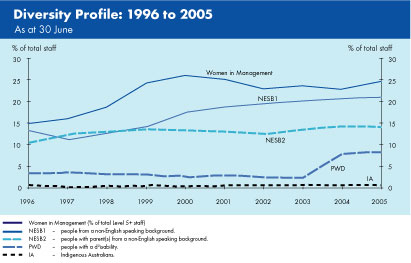
Age
The median age of RBA staff is now 38 years, compared with 37 in 2004 and 36 in 2003. Forty-four per cent of staff are aged less than 35 years, down 1 per cent from last year. Over the next ten years, 28 per cent of RBA staff will be eligible for retirement (aged 55). Comparatively, Australian Public Service (APS) data from last year reports the median age of the APS workforce at 41 years and that 39 per cent of the APS workforce is aged 45 years and over.
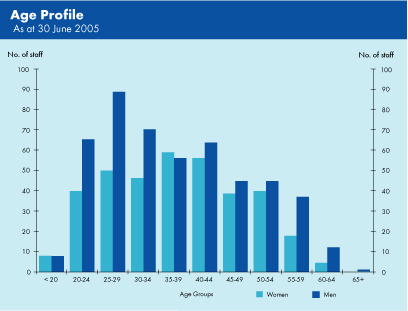
Tenure
There has been little change in the tenure statistics over the last few years. The average tenure remains at 11 years for this reporting period. Fifty-seven per cent of staff have less than 10 years service. This compares to 55 per cent in 2004 and 50 per cent in 2003. Twenty per cent have more than 20 years service and 57 per cent of staff have more than five years service, similar to previous years.
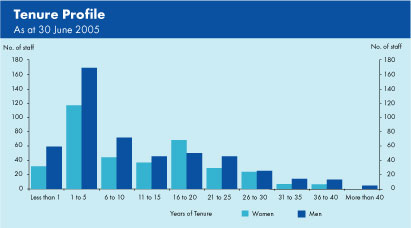
Graduate retention rates were analysed in 2005; it was found that retention of graduates is lower than for other recruits but comparable to relevant external benchmarks. There is evidence that retention of female graduates is marginally lower than male graduates. Graduate retention will continue to be closely monitored with a view to identifying appropriate retention strategies, such as the RBA childcare centre opened earlier this year.
Section 3.2: Gender
Staff Numbers
Over the past seven years staff numbers have remained relatively stable. As at 30 June 2005, women represented 42 per cent of total staff, the same as in 2004.
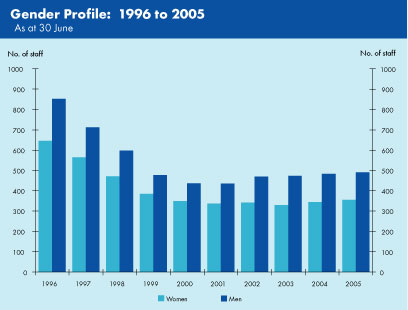
Occupational Groups
Gender representation in the various occupational groups continues to be monitored, as well as changes in occupational structure over time. The two main occupational groups are professional and clerical.
The percentage of women in clerical positions continues to decline, with 40 per cent of women employed in clerical roles in 2005 as compared to 43 per cent in 2004 and 47 per cent in 2003. Clerical positions made up 25 per cent of all positions compared to 26 per cent in 2004 and 41 per cent in 1999. Sixty-eight per cent of clerical positions are held by women. Forty per cent of women hold professional positions, the same as in 2004. Seven years ago representation was 25 per cent.
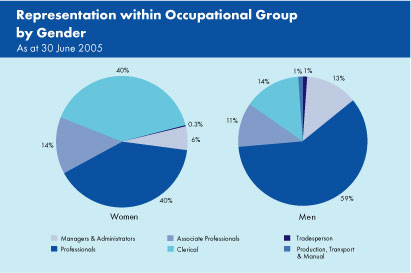
Women in Management
Six per cent of women at the RBA are employed in management positions, an increase of 1 per cent from 2004. This compares to 13 per cent of men. Twenty-four per cent of all RBA management positions are held by women. This is substantially higher than in 1995 when representation was 13 per cent. Further analysis of women in management will be undertaken in the next reporting period.
Transfers, Rotations and Secondments
Transfers and rotations within the RBA, including to overseas and regional offices, are an important means of staff development. Transfers are permanent appointments to a position. The number of transfers recorded for 2004/05 was 65, similar to last year. The percentage of women transferring within the reporting period was 6 per cent down from 9 per cent last year. The transfer rate for men remained unchanged with 9 per cent of men being formally transferred.
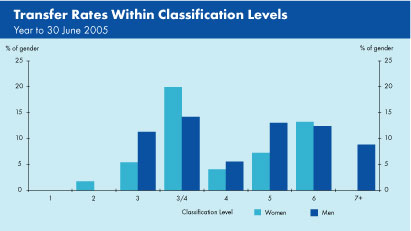
Rotations are temporary movements of staff. The number of rotations increased from 51 last year to 64 in 2004/05 (excluding trainees and graduates). With the exception of 2005 and 2002, the number of rotations had been steadily declining for the past seven years. While women have generally lagged behind men in the transfer rate, the percentage of women rotating has generally been higher than that of men. The past two years have seen a change to this trend. In 2004 the percentage of women rotating was equal to that of men (7 per cent) and in 2005 the percentage of women (7 per cent) was slightly lower than men (9 per cent).
Secondments are also available to other relevant institutions. Over the past year, staff have worked at the Bank for International Settlements, the UK Financial Services Authority, the Australian Treasury, the Australian Taxation Office, and Australian Prudential Regulation Authority.
Graduate Recruitment
Graduate Development Program
In the 2005 recruitment drive 374 applications were received for the Graduate Development Program. The ratio of women to men applying remained the same as the last reporting period and continues to reflect the gender ratio of honours level enrolments in economics at Australian universities. The ratio of women to men called to interview was equal to the previous two reporting periods at 50:50. There was a 10 per cent increase in offers made to female applicants interviewed (57 per cent) while the ratio for men was similar to the last reporting period (59 per cent).
| Year | Women | Men | Total | Ratio |
|---|---|---|---|---|
| 2005 | 15 | 25 | 40 | 38:62 |
| 2004 | 8 | 21 | 29 | 28:72 |
| 2003 | 8 | 26 | 34 | 24:76 |
| 2002* | 14 | 25 | 39 | 36:64 |
| 2001 | 7 | 26 | 33 | 21:79 |
| 2000 | 14 | 20 | 34 | 41:59 |
| *The 2002 figures include 4 graduates that did not participate in the Graduate Development Program (2 male and 2 female) | ||||
Cadetship Award
In the 2004/05 recruitment drive 128 applications were received for the Cadetship Award. Similar numbers of applications have been received over the past four years. The ratio of women to men who apply for the cadetship has remained fairly constant at approximately 35:65 for the last six years. As with graduate applications this ratio continues to reflect the gender ratio of honours level enrolments in economics and related study areas at Australian universities.
In 2004/05, 40 per cent of female applicants and 44 per cent of male applicants were called to interview. There was a decrease in the percentage of offers made to both female and male applicants interviewed; 47 per cent of women and 34 per cent of men who were interviewed were offered positions.
| Year | Women | Men | Total | Ratio |
|---|---|---|---|---|
| 2005 | 9 | 12 | 21 | 43:57 |
| 2004 | 9 | 9 | 18 | 50:50 |
| 2003 | 7 | 10 | 17 | 41:59 |
| 2002 | 3 | 16 | 19 | 15:85 |
| 2001 | 8 | 10 | 18 | 44:56 |
| 2000 | 6 | 9 | 15 | 40:60 |
Individual Contracts
| Occupational Group | Women (%) | Men (%) | Total (%) |
|---|---|---|---|
| Managers | 95 | 97 | 97 |
| Professionals | 75 | 82 | 80 |
| Associate Professionals | 39 | 67 | 54 |
| Clerical | 20 | 21 | 20 |
| Total Staff on Individual Contracts | 49 | 72 | 62 |
Individual employment contracts, providing flexibility in remuneration, are offered to most staff as an alternative to coverage under the RBA's collective agreement. Accepting an individual contract is voluntary, except for staff on the Graduate Development Program and staff at Level 6 and above. As at 30 June 2005, 62 per cent of staff were on individual employment contracts, compared to 53 per cent in 2002. Forty-nine percent of women are on individual contracts as compared to 72 per cent of men. Within most occupational groups, women and men are about equally likely to choose individual contracts, but women are more heavily represented in the occupational groups with the lowest take-up of contracts.
Pay Equity
In 2004/05 women in the RBA earned on average 82 per cent of what men earned, similar to the 2002/03 figure of 83 per cent. This again is likely to reflect a relatively higher representation in lower paid clerical positions. This is also broadly consistent with ABS data which showed nationally, on average, women's earnings were 85 per cent of men's earnings.
Childcare Centre
A major focus in the past year was was on enhancing the RBA's commitment to working parents, particularly women returning to work from parental leave. The RBA's new joint venture with Lend Lease Corporation Ltd, the Billabond Children's Centre, caters for 66 children aged between 0 and 5 years. The RBA has 20 places reserved for the children of staff members. Purpose built, the Centre features modern equipment and facilities for children and their carers. Salary sacrifice arrangements are available to RBA staff.
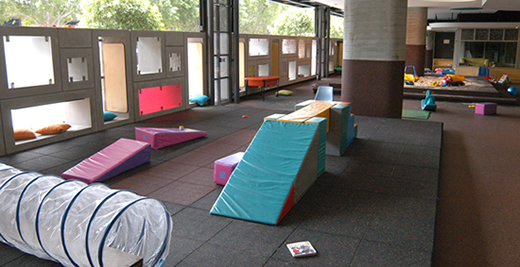
Parent Room
To complement the Childcare Centre, a Parent Room was recently made available for use by staff at Head Office. The room provides a private facility for women returning to work who would like to maintain breastfeeding. Staff on parental leave visiting the RBA that need a private space to breastfeed or change a nappy may also use the room. The room is well equipped and has been accredited by the Australian Breastfeeding Association.
Section 3.3: Work Life Balance
Personal Leave
Personal Leave for caring purposes can be taken either on a half or full day basis. In 2004/05 it was used by 377 staff (44 per cent); with each of those staff taking an average of 3 days leave. This is similar to previous years. Of the 377 staff who took the leave, 53 per cent were men. As a percentage of gender, 49 per cent of all women at the RBA used Personal Leave for caring purposes compared to 41 per cent of men.
Part-Time Work
During the year, 64 staff worked part-time (59 female, five male) compared to 61 (56 female, five male) in 2004. The figures reflect mostly temporary part-time work arrangements.
Parental Leave
Women are entitled to 14 weeks' paid maternity leave and men to one week's paternity leave. The chart below provides a breakdown based on gender for staff commencing paid parental leave.
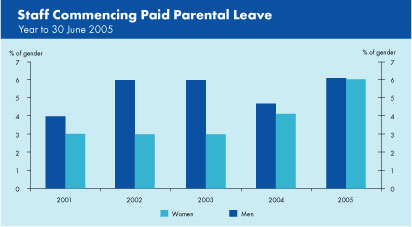
During 2004/05 a total of 50 staff commenced paid parental leave (20 women and 30 men). This is a substantial increase from 2004 where 36 staff commenced paid parental leave (16 women and 20 men).
Of the 14 women completing parental leave three women resigned, a return rate of 79 per cent. This compares to 93 per cent in 2004. Of the 11 women who returned to work in 2004/05, nine elected to work part-time (82 per cent). This compares to 13 women returning in 2004, with 10 electing to work part-time (77 per cent).
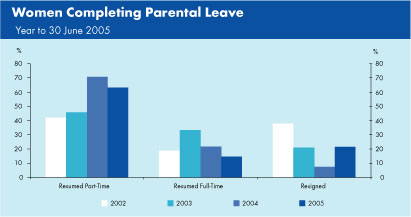
Under enterprise bargaining arrangements the RBA and the Finance Sector Union have agreed to review the RBA's parental leave arrangements once a decision is issued by the Australian Industrial Relations Commission in respect of the Family Provisions Case 2004.
Work and Family Intranet Site
The Work and Family site on the Personnel Department intranet was again reviewed and streamlined. Information on the RBA's Childcare Centre and Parent Room were added to the site.
Fitness Facility
The RBA encourages a healthy lifestyle. In addition to supporting sporting events, the RBA operates a fitness facility at Head Office. The facility is available for use by staff at lunchtime and out of work hours. Staff desiring to use the facility must first attend a training session in the safe use of the equipment. Approximately 545 staff have received this training. During the year additional gymnasium equipment was purchased and at year end 93 staff were attending weekly pilates and yoga classes.
Section 3.4: Indigenous Australians
Staff who have identified as Indigenous Australians continue to account for a very small proportion of staff, 0.6 per cent in 2005.
Business Administration Traineeship
At least one Business Administration Traineeship continues to be designated for Indigenous Australians as a step to encourage a higher representation at the RBA. In 2005, the RBA used additional targeted avenues to promote the vacancies. The position was again successfully filled for 2005. The 2004 Indigenous Australian trainee was employed by the RBA at the end of her traineeship.
National Indigenous Cadetship Project
The feasibility of utilising the Australian Government's National Indigenous Cadetship Project continues to be explored as an additional way of targeting Indigenous Australians for employment opportunities within the RBA.
NAIDOC Week
As one way of recognising Indigenous culture, the RBA took the opportunity to highlight and promote to staff NAIDOC (National and Aboriginal Islander Day Observance Committee) week in July 2004.
Section 3.5: Race-Ethnicity
Representation at RBA
The percentage of staff who identified themselves as NESB1 (staff who are born overseas and whose first language is not English) remains at 21 per cent. These employees remain heavily represented in the RBA's information technology, accounting and audit departments and share a common characteristic of being more highly qualified than other staff at equivalent levels. Consistent with the qualification levels found amongst the NESB1, an analysis of occupational groupings shows that 53 per cent are represented in professional occupations, an increase from 48 per cent in 2004. Three per cent are employed in management positions, an increase of 1 per cent from 2004.
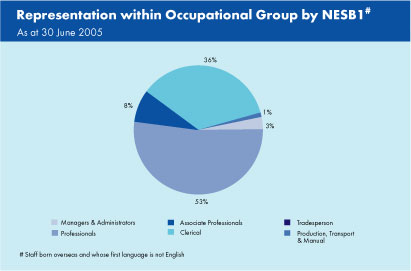
Business Writing Training
The RBA again offered training to staff in business writing to assist with career progression. The objective of the two-day Technical Business Writing course is to tailor training in the area of written communication to reflect the more technical nature of the documents produced by the information technology, accounting and audit departments. The training acknowledges the varying communication styles used by different cultures. In 2004/05, 15 staff who identified themselves as NESB1, and 9 staff who identified themselves as NESB2 attended a business writing course.
Harmony Day
For the week commencing 21 March 2005, the RBA supported and promoted Harmony Day. Staff were provided with information about the meaning of the day via the intranet, the staff magazine Currency, and staff newsletters. Harmony Day ribbons were also available for staff to wear and the staff café provided an array of international dishes throughout the week.
Cultural Awareness Workshop
Twelve participants attended a two-day cultural awareness workshop during the year. The workshop focused on cross cultural recruiting, interviewing and selecting, the multicultural workforce, cultural dimensions and communication in cross-cultural situations. Further sessions are planned for 2005/06.
Work Placement Program
The RBA supported the Orientation to the Workplace Program for migrants during the year. One IT professional worker undertook six weeks' work experience, providing the opportunity to learn about local work culture and work practices.
Section 3.6: People with Disabilities
Representation at RBA
The number of staff who have identified as having a disability remains at 8 per cent in 2005. The increase from 2 per cent in 2003 can be explained by the revised equity and diversity form that was sent to all staff in April 2004. The form assisted in capturing staff who have acquired a disability since commencing at the RBA.
Disability Action Plan: Access & Equity 2003–2005
In December 2003, the RBA launched its second action plan under the Commonwealth Disability Strategy, a government initiative to assist Commonwealth agencies in developing a disability action plan under the Disability Discrimination Act 1992. The Commonwealth Disability Strategy is currently being reviewed. The outcome of this review will be considered in the development of the RBA's next disability plan, to be incorporated in the workplace diversity plan during the next reporting period.
The RBA has achieved good progress on the current Plan initiatives since its implementation; there is one outstanding initiative scheduled for completion by September 2005. The Disability Action Plan Consultative Group continues to meet quarterly to monitor the implementation of the Plan. An update on each of the Plan initiatives is listed at Appendix 4.3.

Membership of Employer Disability Group
In 2005, the RBA became a member of a not-for-profit employer disability group ‘Employers Making a Difference’ (EMAD). The membership provides the RBA with a strategic business partner to assist in the development of disability initiatives as well as an additional resource for staff. During this reporting period EMAD facilitated a half-day disability awareness workshop and is working on a tailored awareness raising session for staff on the Disability Action Plan Consultative Group. During the next reporting period, EMAD will assist the RBA in the development of the next disability action plan.
Awareness
Training & Development
The RBA Disability Awareness Workshop continues to be held annually for staff and managers to raise the level of understanding and awareness in relation to identifying barriers for people with disabilities. The workshop also introduces strategies for overcoming these barriers. A total of 124 staff have attended these workshops since they were first introduced in 1999.
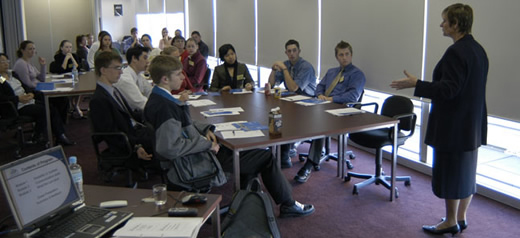
A corporate health program and two half-day workshops, Beyond Blue and Understanding Psychological Problems in the Work Setting, were piloted in 2004; further mental health workshops have been scheduled for the next reporting period.
The First Aiders Network was updated during the year with quarterly information sessions. Topics covered included epilepsy, sports injuries, diabetes, and advanced resuscitation.
Brochure: Supporting Staff with Disabilities
In 2004, the Disability Action Plan Consultative Group worked with Personnel Department to create a disability awareness brochure, Supporting Staff with Disabilities. The brochure continues to be provided to all new starters as part of their induction.
International Day of People with a DisAbility
The RBA once again celebrated International Day of People with a DisAbility on 3 December. Information about the meaning of the day was provided via the intranet and the staff magazine Currency. Displays and information leaflets were also placed in the staff café.
Staff Magazine Feature Articles
During 2004/05 two articles on disability featured in the staff magazine. The first article highlighted the achievements of the RBA's Systems Accessibility Technical Group and promoted the assistive technologies available at the RBA. The article featured one staff member using a portable CCTV system, purchased by the RBA to assist him in his regular work duties.
The second article, also aimed at raising awareness, provided staff with an update on various disability initiatives. The article highlighted resources available to staff at the RBA, including the new confidential disability employer information line available to all staff through membership of EMAD.
Access
Various facilities at Head Office were upgraded as part of the Access Improvement Program. The ground floor foyer reception desk was redesigned to comply with the Disability Discrimination Act 1992 and accessible lifts were installed in the banking chamber and the Museum of Australian Currency Notes. Work commenced on upgrading the six Head Office passenger lifts. The upgrade includes improved disability access features; one refurbished lift was in operation at end-June 2005.
Accessibility
Internet
In March 2005, the Bank opened the Museum of Australian Currency Notes in its Head Office building. As part of that development a new website depicting much of the content of the Museum was launched. The Museum website is fully compliant with the W3C Web Content Accessibility Guidelines.
The Bank also continued its program of review and enhancement of its regular website content to improve compliance with the W3C Guidelines. Some examples of improvements made during 2004/05 are: replacement of a non-compliant flowchart diagram with text and smaller accessible images; and amendments to various hyperlink text labels to more accurately describe the hyperlinked website material.
Assistive Technologies
A demonstration of devices to assist people with a hearing impairment was arranged in 2004. A portable FM Phonic hearing system was purchased for the HC Coombs Centre for Financial Studies and FM Phonic conference microphones were purchased for use in training or meetings. A permanent induction loop was installed in the RBA's training rooms and in one conference room. Other assistive technologies were purchased for individuals with various disabilities to assist them in their every day work.